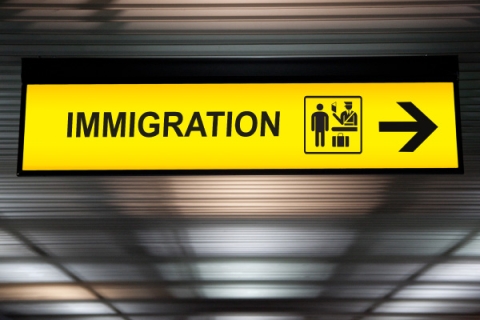
In 2012, then Home Secretary Theresa May announced a policy strategy aimed at combatting 'illegal immigration' by making life so unbearable for undocumented migrants that they would voluntarily choose to leave.
In May's own words: "The aim is to create, here in Britain, a really hostile environment for illegal immigrants". Whilst the concept of a ‘hostile environment’ had first been introduced in 2007 by then New Labour Immigration Minister Liam Byrne, 2012 saw the first systemic implementation of this strategy.
Most basically, the policies aimed toward the 'Hostile Environment' intended to cut off undocumented migrants from access to any public services, including healthcare services. In addition, the government pushed to make working or renting a safe place to live impossible for migrants without adequate paperwork.
Hostile Environment policies and the production of migrant precarity
The policies which emerged from the Hostile Environment effectively called upon the British public to take on border policing roles in their everyday lives, as explored by the Centre for Research on Migration, Refugee’s and Belonging documentary film Everyday Bordering. Suddenly, landlords, doctors, employers, staff across educational facilities, community workers and more became legally responsible for assessing individuals' immigration status before engaging them in their work, with mistakes punishable by law. These policies have woven suspicion and fear into the very fabric of everyday life in the UK today, and have fundamentally undermined trust in public services for those most in need.
The political and legal landscape of the Hostile Environment also prompted a widening of the 'No Recourse to Public Funds' (NRPF) policy which manages the accessibility of welfare support to migrants living in the UK. Today, NRPF dictates that any non-EEA migrant who has not secured 'Indefinite Leave to Remain' in the UK is unable to access 'most benefits, tax credits or housing assistance' – including local authority homelessness services. NRPF affects diverse groups of migrants from undocumented migrants to asylum seekers to international students and migrant workers in employment, including migrants who have survived trafficking, torture and modern slavery. Indeed, for women escaping abusive living conditions NRPF status even forecloses access to mainstream refuges. Children too can be subject to NRPF, leaving them ineligible for free school meals.
The correlation, then, between Hostile Environment policies and abject poverty is both direct and stark. Furthermore, NRPF is only lifted in exceptional circumstances, such as when a migrant can prove beyond doubt that they have become destitute. In mid-2020, a High Court hearing ruled that the requirement to prove actual destitution, as opposed to a risk of destitution, breached Article 3 of the Human Rights Act which relates to the prohibition of inhuman or degrading treatment.
Impacts on European Economic Area (EEA) nationals
Currently, migrants who are EEA nationals are not subject to NRPF conditions. However, it is unclear how this status may change once the UK officially leaves the European Union in January 2021. Nevertheless, EEA nationals remain subject to a complex eligibility criteria when it comes to accessing public funds and state welfare services, with new policies aimed at 'restrict[ing] access to benefits for migrants from the EEA' (as the government itself states) being introduced in the years since the 'Hostile Environment' announcement in 2012.
In order to access the welfare system today, EEA nationals have to prove the status of their residency in the UK through a number of different conditions, including time spent in the UK and intention to settle (assessed through the Habitual Residency Test) as well as a particular history of employment. The latter requires employment that can be traceable through HMRC – meaning that the less official or uncontracted forms of employment which migrants are often compelled to accept are not considered. The shift to Universal Credit has also exacerbated the inaccessibility of the benefits system for EEA migrants.
Finally, as an EEA migrant's country of origin can also impact eligibility, evidence suggests that the labyrinth complexity of these policies frequently leads eligible migrants to be deemed ineligible by frontline staff who do not fully understand the criteria themselves.
Significantly, all migrants in the UK – whether EEA or non-EEA are subject to other Hostile Environment policies which further impact their capacity to pursue stable lives in the UK, as we will continue to explore later on in the series.
What does the Hostile Environment do?
It is crucial that any discussion of migrant homelessness in the UK is situated within the wider political context of the 'Hostile Environment'. Central to this policy strategy, and its particular approach to regulating immigration, is the disruption of the possibility of home – both as a material and an imagined space.
Hostile Environment policies target the right to belonging through a racialised logic of worthy and unworthy life which denies many migrants the resources necessary to make secure and comfortable lives in Britain. Indeed, in taking aim at the bearability of life, the Hostile Environment strategy explicitly marks particular communities for harm. This harm includes the heightened vulnerability of migrants to homelessness, and we will focus in more closely on these connections between Hostile Environment and homelessness in the next post in our series.
This post is part of a series titled Homeless Migrants and COVID-19: Mapping the layers of crisis.
This post reflects the views of the University of Portsmouth research team only, and not those of our project collaborators the homelessness charity St Mungo's.
Author: Dr Charlotte Sanders.
